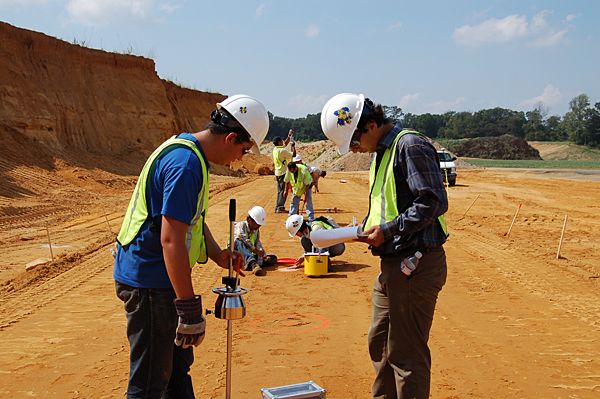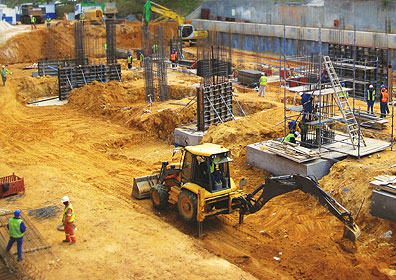Understanding the Basics: Concerning Geotechnical Engineering in Modern Construction
Wiki Article
An Extensive Summary of Geotechnical Engineering Techniques and Their Effect On Modern Civil Design Projects
Geotechnical design offers as the backbone of modern civil engineering, giving important strategies that resolve the intricacies of subsurface problems. The interaction of dirt analysis, foundation style, and cutting-edge innovations shapes the honesty and sustainability of framework projects.Importance of Geotechnical Engineering
Geotechnical engineering offers as a critical structure for civil engineering jobs, affecting the safety and security and security of frameworks. This self-control concentrates on the actions of soil and rock products, offering essential insights that lead the design and building procedures. By understanding the interaction in between the earth and engineered structures, geotechnical designers can evaluate risks connected with ground problems, such as negotiation, incline security, and liquefaction.The significance of geotechnical engineering prolongs beyond mere structural integrity; it plays an important role in environmental security and sustainability. Appropriately executed geotechnical assessments make sure that projects minimize their eco-friendly impact and follow governing needs (all about geotechnical engineering). Geotechnical engineering is important in site selection, allowing engineers to recognize suitable areas for construction that alleviate potential dangers.
On top of that, geotechnical engineering fosters development in civil design by advancing methods for ground renovation, structure style, and excavation. The technique's contributions are critical in attending to obstacles presented by varying dirt conditions, thus promoting risk-free and efficient facilities advancement. On the whole, the relevance of geotechnical engineering is critical in making sure that civil design tasks are not just viable however also resistant against synthetic and all-natural adversities.
Secret Techniques in Geotechnical Design

Another crucial technique is dirt stabilization, which involves changing dirt properties to enhance load-bearing capability or reduce negotiation. Methods such as adding cement, lime, or making use of geosynthetics are typically used to attain dirt renovation.
Ground renovation strategies, including vibrant compaction and vibro-replacement, are additionally vital. These techniques intend to densify soft or loosened soils, enhancing their toughness and minimizing liquefaction potential in seismic locations.
Keeping structures, such as sheet stacks and dirt nailing, are utilized to support excavations and protect against soil motion. Additionally, incline stablizing methods, including water drainage systems and maintaining wall surfaces, are important for alleviating landslide risks.

Soil Analysis and Examining Approaches
Efficient soil analysis and screening techniques are vital for comprehending the physical and chemical homes of soil, which straight affect engineering choices. A detailed evaluation of dirt attributes is vital for predicting actions under different loading conditions and ecological influences.Typical soil screening methods include both field and research laboratory methods. Area tests, such as the Criterion Penetration Examination (SPT) and Cone Infiltration Test (CPT), supply immediate insights right into soil toughness, density, and stratification. These tests assist designers assess site problems successfully before more considerable laboratory evaluations.
Research laboratory testing methods, such as Atterberg limits, grain dimension distribution, and compaction tests, are critical for figuring out soil plasticity, moisture web content, and ideal compaction degrees. Additionally, progressed methods like triaxial examinations and consolidated undrained (CU) tests provide beneficial information on shear toughness and effective stress and anxiety parameters - about geotechnical engineering.
Chemical screening, consisting of pH, electric conductivity, and organic material analysis, is also important for understanding potential soil contamination and its influence on construction products. Jointly, these dirt analysis and testing methods form the structure of educated decision-making in geotechnical design, making certain the safety and stability of modern civil design tasks.
Structure Style Approaches
Foundation layout strategies are critical in making certain the security and durability of structures. These strategies can be classified into shallow and deep foundations, each suited to details dirt conditions and filling situations. Superficial foundations, such as spread footings and floor covering foundations, are generally used when surface area soils have adequate bearing ability. They distribute the lots over a bigger area, minimizing negotiation threats.In contrast, deep structures, including stacks and pierced shafts, are employed when surface area soils are poor or weak for supporting the framework. These foundations transfer tons to much deeper, a lot more secure soil or rock layers, making them crucial for skyscrapers and bridges in challenging geotechnical problems.
Picking the ideal structure layout entails extensive geotechnical examinations, consisting of soil make-up, birthing capacity, and groundwater conditions. Moreover, engineers have to consider aspects such as negotiation, side loads, and prospective seismic task to ensure the foundation's efficiency with time.
Inevitably, a well-executed structure design is a pivotal element of civil design, straight affecting the safety, toughness, and capability of frameworks. geotechnical companies in south africa. By lining up structure kinds with site-specific problems, engineers can efficiently minimize dangers associated with foundation failure
Developments Forming Civil Engineering

Lasting materials, such as high-performance concrete and recycled accumulations, are additionally getting grip, promoting environmentally friendly methods while keeping architectural honesty. In addition, progressed geotechnical methods, such as ground enhancement and deep mixing approaches, are improving the stability of foundations in tough dirt conditions.
Moreover, the use of drones and remote picking up innovation is improving website monitoring and evaluating, offering real-time data that help in handling construction progression and safety and security. The application of ingenious construction methods, such as premade and modular construction, further expedites task timelines and lowers waste. Jointly, these advancements are not only transforming civil engineering techniques however likewise ensuring that modern-day facilities satisfies the demands of an expanding worldwide populace while attending to environmental concerns.
Verdict
In final thought, geotechnical engineering strategies geotechnical engineer description are essential to the success of modern civil design projects. The application of website investigation, dirt stabilization, and ground renovation methods guarantees the safety and security and stability of framework. Advancements such as Building Info Modeling (BIM) and progressed tracking technologies additionally enhance job efficiency and precision. By employing these methods, designers can reduce threats and contribute to the growth of resilient metropolitan environments, eventually cultivating sustainable development and safety in civil engineering techniques.Geotechnical design serves as the foundation of modern civil engineering, offering important methods that resolve the intricacies of subsurface conditions.Geotechnical engineering offers as an important foundation for civil engineering projects, affecting the safety and security and security of structures.In enhancement, geotechnical design cultivates development in civil engineering by advancing strategies for ground improvement, structure design, and excavation. On the whole, the value of geotechnical engineering is extremely important in guaranteeing that civil engineering jobs are not just viable yet also resilient versus manufactured and natural hardships.
In verdict, geotechnical engineering strategies are indispensable to the success of contemporary civil design tasks.
Report this wiki page